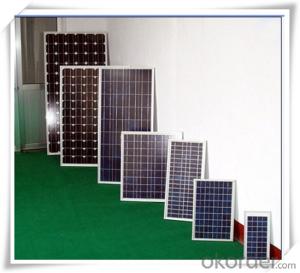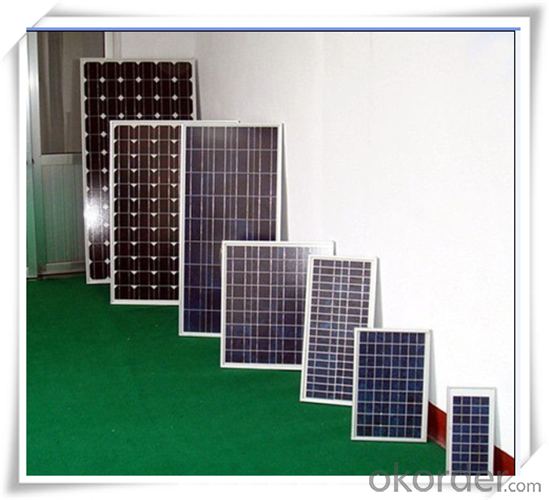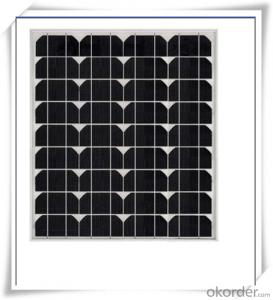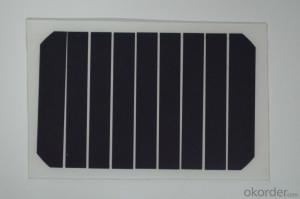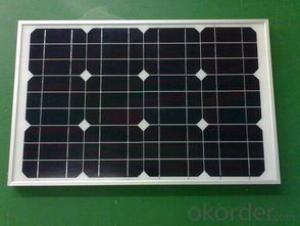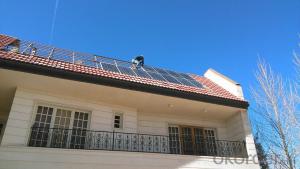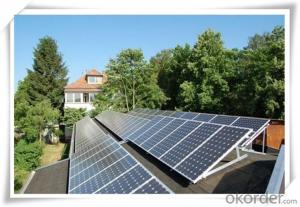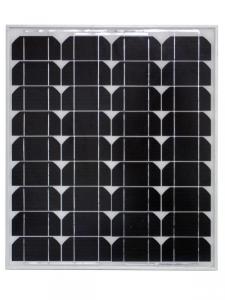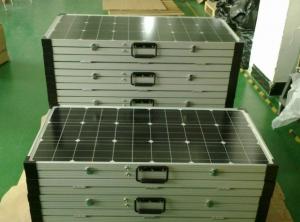Roofing Solar Panels - Monocrystalline Solar Panel from 1.5w to 300w CNBM
- Loading Port:
- Qingdao
- Payment Terms:
- TT OR LC
- Min Order Qty:
- 10 set
- Supply Capability:
- 300000 set/month
OKorder Service Pledge
OKorder Financial Service
You Might Also Like
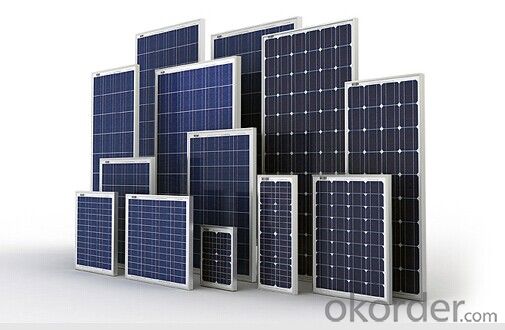
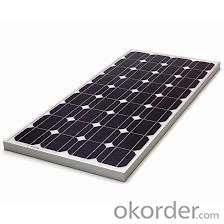
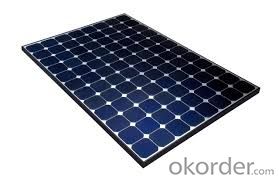
Monocrystalline Solar Modules
We offers a range of small, medium and large monocrystalline solar modules, designed for a range of requirements.
Specifications:
Tolerance | +/- 3% |
Cell | Monocrystalline silicon solar cells |
N0. of Cells | 72 (12 x 6) |
Dimension of Modules (mm) | 1581 x 809 x 40 |
Weight (kg) | 15.5 |
Limits:
Operating Temperature | -40~+85? |
Storage Temperature | -40~+85? |
Maximum System Voltage | 1000 VDC max. |
Hail Impact | Diameter of 28mm with impact speed of 86km/h |
Temperature and Coefficients:
NOCT | 48C+/-2? |
Voltage temperature coefficient (%/K) | -0.34 |
Current temperature coefficient (%/K) | 0.09 |
Power temperature coefficient (%/K) | -0.37 |
Characteristics:
Model: | SGM-160D | SGM-165D | SGM-170D |
Max-power voltage Vmp (V) | 34.5 | 35.4 | 35.8 |
Max-power current Imp (A) | 4.64 | 4.66 | 4.75 |
Open-circuit voltage Voc (V) | 41.75 | 43.6 | 43.32 |
Short-Circuit Current Isc (A) | 5.32 | 5.08 | 5.38 |
Max-power Pm(W) | 160 | 165 | 170 |
Model: | SGM-175D | SGM-180D | SGM-185D |
Max-power voltage Vmp (V) | 36.1 | 36.2 | 36.2 |
Max-power current Imp (A) | 4.85 | 4.97 | 5.11 |
Open-circuit voltage Voc (V) | 43.68 | 43.8 | 44.8 |
Short-Circuit Current Isc (A) | 5.49 | 5.48 | 5.51 |
Max-power Pm(W) | 175 | 180 | 185 |
STC: Irradiance 1000W/m2, Module temperature 25?, AM=1.5
Monocrystalline Solar Panels Specifications Range
Maximum Power (Pm) | Dimension | Weight | Operating Voltage (Vmp) | Operating Current (Imp) | Open Circuit Voltage (Voc) | Short Circuit Current (Isc) |
3W | 158x241x25mm | 0.5kg | 8.5V | 0.36A | 10.5V | 0.4A |
4W | 308x166x25mm | 0.77kg | 8.5V | 0.47A | 10.5V | 0.54A |
4W | 308.x166x25mm | 0.77kg | 16.8V | 0.24A | 21V | 0.27A |
5W | 296x215x25mm | 0.3kg | 16.8V | 0.48a | 21V | 0.54A |
10W | 286x406x25mm | 1.5kg | 16.8V | 0.59A | 21V | 0.66A |
12W | 286x406x25mm | 1.5kg | 16.8V | 0.71A | 21V | 0.8A |
14W | 286x541x25mm | 2kg | 16.8V | 0.83A | 21V | 0.96A |
16W | 286x541x25mm | 2kg | 17.2V | 0.93A | 21.5V | 0.99A |
18W | 296x541x25mm | 2.4kg | 18.8V | 1.07A | 21V | 1.2A |
20W | 296x641x25mm | 2.4kg | 17.2V | 1.15A | 21.5V | 1.24A |
24W | 541x451x25mm | 3.15kg | 16.8V | 1.14A | 21V | 1.56A |
26W | 541x451x25mm | 3.15kg | 17.2V | 1.51A | 21.5V | 1.63A |
30W | 296x966x25mm | 3.85kg | 16.8V | 1.78A | 21V | 2.03A |
36W | 541x641x35mm | 4.7kg | 16.8V | 2.14a | 21V | 2.4A |
40W | 541x641x35mm | 4.7kg | 17.2V | 2.33A | 21.5V | 2.5A |
55W | 1057x457x35mm | 6.6kg | 17.6V | 3.12A | 21.6V | 3.3A |
70W | 546x1196x35mm | 8.5kg | 16.8V | 4.15A | 21V | 4.7A |
75W | 546x1196x35mm | 8.5kg | 17.2V | 4.36A | 21.5V | 4.8A |
80W | 546x1196x35mm | 8.5kg | 17.6V | 4.55A | 21.6V | 4.9A |
110W | 1066x811x40mm | 11.8kg | 17.6V | 6.25A | 21.6V | 6.6A |
150W | 1066x811x40mm | 14kg | 34.4V | 4.36A | 43.2V | 4.7A |
- Q: What is the efficiency of modern solar panels?
- The efficiency of modern solar panels typically ranges from 15% to 20%, with some advanced models reaching up to 22%.
- Q: We want make solar panel for our home use. but we have no any right idea how we can make it. we want to make it with cheap prices.we also want to know the proper size of solar panel.where we can take help about making a solar panel
- Create okorder
- Q: Can solar panels be used in areas prone to hurricanes or earthquakes?
- Yes, solar panels can be used in areas prone to hurricanes or earthquakes. While these natural disasters can pose risks to solar panels, proper installation and structural reinforcement can ensure their resilience. Additionally, advancements in technology have led to the development of more robust solar panels that can withstand extreme weather conditions. However, it is important to consider local regulations, building codes, and additional safety measures to mitigate potential risks.
- Q: What is the average lifespan of a solar panel?
- The average lifespan of a solar panel is typically around 25 to 30 years.
- Q: I have been thinking about getting solar panels for my house. What do you think I should get? Companies? Prices? I also have another question. How much energy can a small solar panel produce?
- so, you think that the best idea is to just keep focusing on oil and not to try to compete? EVERY CON I've talked to on here goes on and on about how green energy is a bad idea? yet, here's China, with a focused goal and actually making it happen... wonder how far we would be in the US without the cons fighting us every step of the way... how's that buggy whip business going cons? THAT'S what we mean when we say thanks to Republicans do you think green energy isn't going to happen? China's already doing it... we can either catch up, or give up... and give up has a big unempmloyment rate attached to it...
- Q: quot;Does it take more energy to produce a solar panel than what the same solar panel can generate in its useful lifetime?quot;
- Thor is right and wrong. Solar panel will produce more than they take to make. My solar panels only have a 0 year estimated useful life. They may actually last longer, but with time they lose efficiency. Here in Phoenix where the sun shines all the time, a decent solar system you purchase and pay to have installed will pay back the original investment in 5-20 years. If you are a handyman and can install it yourself it will pay back sooner. Solar is a great system for reducing CO2 pollution, but until grid power rates increase a lot, it is still not very cost effective in most areas. It is also a myth that anyone can just install a solar system and get off grid power. Most people could not afford it, and most people would not like not having heat or air. Any system that normal people could afford could not supply anywhere near enough power for heating or air conditioning.
- Q: what is solar panel? full description needed?
- Solar panels are devices that convert light into electricity. They are called solar panels because most of the time, the most powerful source of light available is the Sun, called Sol by astronomers. Some scientists call them photovoltaics which means, basically, light-electricity. A solar panel is a collection of solar cells. Lots of small solar cells spread over a large area can work together to provide enough power to be useful. The more light that hits a cell, the more electricity it produces, so spacecraft are usually designed with solar panels that can always be pointed at the Sun even as the rest of the body of the spacecraft moves around, much as a tank turret can be aimed independently of where the tank is going. DS's solar cells are even more efficient than regular solar panels made for satellites because they use solar concentrators.
- Q: i used 734 killowatts of power last month, any idea on how many solar panels i would need. What im looking for is to somehow hook up my central air to solar panels.
- LOL!! There is a lot more to this than you might imagine. This is a very rough approximation but look at the attached and column labeled 6.3KW. Look down that column and you see where it says Est. First Year KWH Generated ,025. So if we were to assume that each month it will produce ,025/2 kwh. (not true for January but I am trying to keep this simple. The installed price without any rebates is $44,050. ;-) Sorry! You will find some a little cheaper... some a little more expensive but none are a LOT cheaper than this. (this price does not even include energy storage, so the sun goes down and you will stop producing electricity). This is why, when people start looking at this sort of thing, they always do what they can to conserve electricity first. It is always much cheaper to conserve, then worry about alternate energy.
- Q: Do solar panels increase property value?
- Yes, solar panels do increase property value. Multiple studies have shown that homes equipped with solar panels tend to sell for higher prices compared to similar homes without solar panels. The added value comes from the potential savings on energy bills, the positive environmental impact, and the increasing demand for sustainable energy sources.
- Q: Can solar panels be used in areas with high levels of air humidity or moisture?
- Yes, solar panels can be used in areas with high levels of air humidity or moisture. While excessive moisture can potentially reduce the efficiency of solar panels, modern solar panel designs are equipped to handle such conditions. They are built with protective coatings and materials that prevent moisture penetration and corrosion. Additionally, regular maintenance and cleaning can further ensure optimal performance in humid environments.
Send your message to us
Roofing Solar Panels - Monocrystalline Solar Panel from 1.5w to 300w CNBM
- Loading Port:
- Qingdao
- Payment Terms:
- TT OR LC
- Min Order Qty:
- 10 set
- Supply Capability:
- 300000 set/month
OKorder Service Pledge
OKorder Financial Service
Similar products
Hot products
Hot Searches
Related keywords
